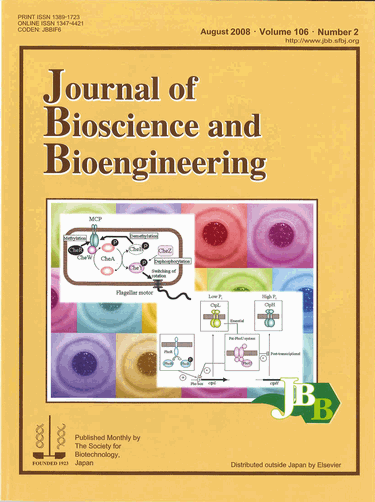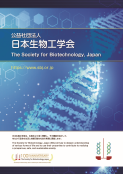Journal of Bioscience and Bioengineering Vol. 106, No. 2 (2008)
Vol. 106, August 2008
Motile bacteria sense changes in the concentration of chemicals in environments and behaviorally respond to them. This behavioral response is called chemotaxis (background photos show positive chemotaxis to agarose plugs containing an attractant).
The molecular mechanisms underlie bacterial chemotaxis have been studied extensively with Escherichia coli (the left panel). It is thought that the chemotaxis machinery of other motile bacteria is basically similar to that of E. coli.
E. coli possesses only five chemotaxis sensory proteins. However, sequence analysis of bacterial genomes revealed that quite a few environmental bacteria have a number of (20-50) chemotaxis sensory proteins, suggesting that these environmental bacteria can respond to much more chemical compounds than E. coli does. For example, Pseudomonas aeruginosa is attracted to inorganic phosphate (Pi), but not E. coli. Pi taxis in P. aeruginosa is induced under conditions of Pi limitation. P. aeruginosa PAO1 possesses two chemotaxis sensory proteins for Pi, CtpH and CtpL, which are functional at different concentrations of phosphate (the right panel).
CtpL serves as the major chemoreceptor for phosphate at low concentrations, while CtpH is required for exhibiting phosphate taxis at high concentrations of phosphate. The induction mechanism of phosphate taxis in P. aerguginosa is complicated. In P. aeruginosa, phosphate limitation elicits the synthesis of several proteins such as alkaline phosphatase, phosphate-specific transport (Pst) complex, a hemolytic phospholipase C and a nonhemolytic phospholipase C. These gene promoters are positively regulated by a PhoB/PhoR two component regulatory system, whereas the Pst complex, together with PhoU, negatively regulates the phosphate regulon in P. aeruginosa. CtpH expression is not dependent on the PhoB/PhoR proteins.
The Pst complex and PhoU are likely to exert a negative control on CtpH expression at posttranscriptional level. The ctpL gene is a member of the phosphate regulon and PhoB/PhoR are essential for its transcription. A putative PhoB-binding sequence (pho box) exists in the ctpL promoter region. The ctpL gene is constitutively transcribed in pst and phoU mutants of P. aeruginosa, however, the mutant strains fail to show a chemotactic response toward low concentrations of phosphate, suggesting that the Pst complex and PhoU are required for the phosphate detection by CtpL.
Related article: Kato, J., Kim, H-E., Takiguchi, N., Kuroda, A., and Ohtake, H., “Pseudomonas aeruginosa as a model microorganism for investigation of chemotactic behaviors in ecosystem“, J. Biosci. Bioeng., vol. 106, 1-7 (2008).
Illustration designed by Ms. Azusa Fujita.
⇒JBBアーカイブ:Vol.107 (2009) ~最新号
⇒JBBアーカイブ:Vol. 93(2002)~Vol. 106(2008)



.gif)